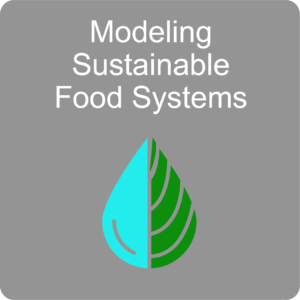Modeling Sustainable Food Systems
Food Security Unit Plan

Course: Environmental Science, AP Environmental Science, Integrated Science, Biotechnology, STEM courses, Agricultural Science, Statistics, Human Geography, Biology, AP Biology (after test), Social Studies
Unit: Ecology, Ecosystems, Food Webs, Biogeochemical Cycling, Biomolecules, Interdependence, Global or Community Issues, Nutrition, Systems, Climate Change, Nature of Science
Curriculum Module Summary
 Students take an interdisciplinary approach to understand a global issue. The driving question: “How can we think and act on a systems-level to produce and consume food resources that will be environmentally sustainable and sufficient for global needs?” Students learn that systems thinking is helpful in identifying influences and interactions within the food security system. After critically examining the environmental tradeoffs involved with various food production techniques, students engineer a system, such as an aquaponic system, to evaluate the potential of scaling up aquaponics to fill the future food gap. Next, students examine the origins of food and resources required to produce it. Throughout this module, student groups investigate various aspects of the food crisis in a specific country, which culminates in a UN council meeting to propose a solution.
Students take an interdisciplinary approach to understand a global issue. The driving question: “How can we think and act on a systems-level to produce and consume food resources that will be environmentally sustainable and sufficient for global needs?” Students learn that systems thinking is helpful in identifying influences and interactions within the food security system. After critically examining the environmental tradeoffs involved with various food production techniques, students engineer a system, such as an aquaponic system, to evaluate the potential of scaling up aquaponics to fill the future food gap. Next, students examine the origins of food and resources required to produce it. Throughout this module, student groups investigate various aspects of the food crisis in a specific country, which culminates in a UN council meeting to propose a solution.
Teacher Guides
- Overview Flowchart: Use this Food Security Module Flow Chart to help direct the flow of this module
- FS Curriculum Overview (11/01/18) via PDF
- Complete Food Security (FS) Module (updated 02/23/2021) via PDF
- Project Feed 1010 website: projectfeed1010.com
- Project Feed 1010 data management site: pf1010.systemsbiology.net. (Please note, this is currently unavailable – if you would like access to this systems, please reach out to us at see@isbscience.org)
- A number of helpful videos can be viewed on our YouTube channel: https://www.youtube.com/channel/UCbMLa5LinsdPjivEtIDgJNA
- Examples of teacher Donor’s Choose projects that have been fully funded to build aquaponic systems
- Jennifer Barreto – Florida: Funded
- Tami Caraballo – Washington: Funded
- Tami Caraballo – Washington – Year 2: Funded
- Jennifer Barreto – Florida – Year 2: Funded
- Lesson Plans: The actual teacher lesson plans are located on the lesson pages that can be accessed from the main list below or from the left-hand menu. You can also find them in the master PDF.
- Standards Addressed: This module aligns with the Next Generation Science Standards. Please see disciplinary core ideas, science and engineering practices (SEP), and crosscutting concepts (CCC) addressed in this module in the buttons on the upper-left of this page, arranged in three-dimensional bundles. The bundled NGSS are also listed in the master PDF. Please also see the individual lesson plan pages for additional information on what students learn and do. For more information on the standards our modules address, please also see our Standards Addressed page.
- If you need any more information and/or have questions, please feel free to contact us.
Lesson Overview and Pacing Guide:
This approximately 3-week long unit consists of 7 (multi-day) lessons plus one Application Lab designed for 50-minute periods.
- Lesson FS1: Introduction to Food Security (1 class period) – Food security is a foreign concept to many Americans. Most believe that chronic hunger and malnutrition happens only to people in developing nations or to the homeless. In reality, 1 in 6 people in America go hungry every day and are not food secure. Throughout the lesson, students will develop and refine their understanding of food security and they are able to compare different countries and analyze what food security issues they have based on the three pillars using global statistics.
- Lesson FS2: Critically Evaluating Food Production Techniques (2 class periods)– A variety of agricultural production systems are used to produce food around the world. Some systems rely on the continuous addition of resources, while others use resources more efficiently. In this lesson, students evaluate various food production techniques in terms of their environmental sustainability and potential for producing enough food to feed a growing world population.
- Application 1: Designing, Constructing and Re-engineering a System (2 class periods)– Using mathematics and computational analysis, students design aquaponic systems to be part of the solution to food insecurity in a developing country. In this NGSS STEM activity and optional lab, students can either use real data collected from an aquaponic system at Institute for Systems Biology (ISB) or data from their own aquaponic system to calculate water efficiency and the effects of scaling up a system.
- Lesson FS3: Who Cares? Stakeholders! (1 class period) – Stakeholders are a vital part of the food security system. It is important for students to realize that to solve the global issue of food insecurity, all of the stakeholders’ voices must be represented. In a system, there are often trade-offs to being able to make something work. They will have an impact on the system and other stakeholders, based on the choices they make and the resources they use.
- Lesson FS4: Food Security as a System (2 class periods) – The goal of this lesson is to encourage students to look at the topic of food security using a systems approach, and to evaluate the stability of our global food production by assessing the interactions within the system. Students will review the definition of a system and discuss how approaching a problem or issue by modeling it as a system can lead to both improved understanding and more effective problem-solving.
- Lesson FS5 – Why Don’t We Just Grow More? (1 class period) – Students will continue to explore the idea that when nodes are interacting in a system, modifying one node can have far-reaching consequences for the entire system. In this lesson, students will focus on the stakeholders introduced in Lesson FS3, by analyzing an article and evaluating the impact that possible solutions to global food insecurity will have on stakeholders.
- Lesson FS6 – Where Does Our Food Come From? (1-2 class periods)– How does our food get from farm to table and what resources are required to get it there? In this activity, students will play a game to produce pizza. While the game uses economics as a driving force to model food production, students must use a systems thinking approach to strategize and make decisions.
- Lesson FS7: United Nations Food and Agriculture Organization Summit (2-3 class periods) – Students conduct a United Nations Food and Agriculture Organization Summit (UN Summit) in order to address the food security challenges of the countries they’ve researched throughout the Food Security module. Through the UN Summit, students recommend actions to improve the food production system as a representative of their country and follow-up with an individual critical evaluation of the proposed actions.

